Before the Internet, before cable, before we had more than CBC on a black and white TV, my friends and I knew the joy of squashing pennies on railroad tracks.
By Mark Fenton
Published December 04, 2015
Defacing current coins
*456. Every one who
(a) defaces a current coin, or
(b) utters a current coin that has been defaced,
is guilty of an offence punishable on summary conviction.
R.S., c. C-34, s. 414.—The Criminal Code of Canada
I lived my first years in a house on the edge of Regina. The roads were straight as the horizon from my bedroom window. Nevertheless I soon found myself far from the straight path.
Before the Internet, before cable, before we had more than CBC on a black and white TV, my friends and I knew the joy of squashing pennies on railroad tracks. We would meet after school and walk the several kilometers to Railroad Street (Google that if you don't believe me.) Half the fun was awaiting the arrival of a train. We were patient as terrorists.
From the age of six to eight, my weekly allowance was $.05. So this activity deployed a full weekday's wages. It was worth every penny.
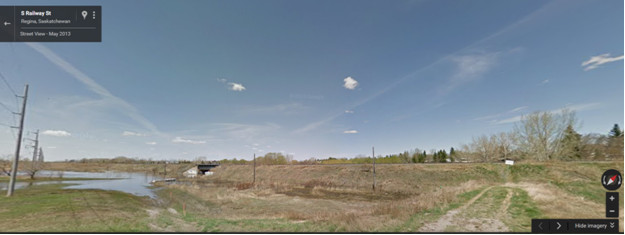
And since we're speaking of finances, it is within neither the RTH budget nor my own to put me in Regina for a photograph. Google Street View does it better than I would anyway.
Consider the expressionistic vanity of the hydro-poles leaning backwards into the shot. There's little glamour to their lives. They take it where they can get it.
In the bottom half of the frame the wide angle creates an extreme double vanishing point of road and waterway. While in the upper half, twin jet trails move to a single vanishing point, which can only mean a mid-air collision.
Zapruderlike, the autonomic Google Camera inadvertently records menace.
In the middle of the journey of our life
I found myself astray in a dark wood
Where the straight road had been lost sight of.
—Dante (translated by Seamus Heaney)
The nearest wood to my house is reached by walking through the parking lot of Christ the King Cathedral (how fitting is that!), and down into Kay Drage Park. The railroad track supplies the park's eastern boundary.
For a writer, journeys into woods are an instant opportunity to reflect on one's life thus far. Simple man that I am compared to Dante, whose flashbacks contained reflections on political exile and an education by distinguished Florentine masters, I simply wanted to relive the childhood magic of squashing pennies with trains. (Perhaps this puts me closer to the childish folly of dementia usually associated with extremely advanced age, than to the ruminations of mid-life. Alas.)
So. On a late afternoon in November I walked to the track armed with a bag of pennies I hadn't been clever enough to spend while they were still currency.
When I went to retrieve them the next day, they were a poor facsimile of the thinness and spreading I'd relished, as a child in Saskatchewan. The reason was simple. They'd been struck by a GO train, which wasn't heavy enough to crush them the way I desired. I needed my pennies to miss the GO train and be crushed by the weight of a cargo engine.
I consulted the GO Transit website
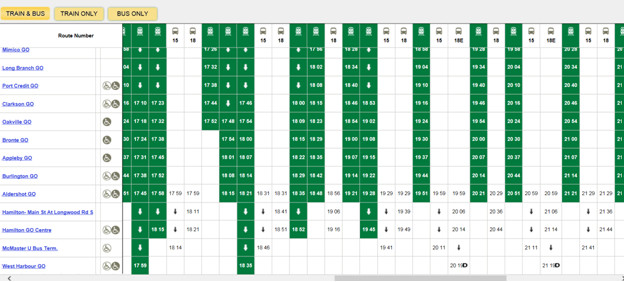
to find when the last GO train arrived into Hamilton.

7:45 pm. Which meant if I headed out at 7:30 I'd be certain to witness the last commuter train. At that moment I could place my pennies in the path of a really heavy train engine bound to come sometime in the night. (Trust me. I hear them.)
Autumn darkness fell. I lay on my bed in a cold sweat. The images in my head were like a scene from an Alfred Hitchcock movie describing a perilous mission. As is SOP for anyone orchestrating a caper, I imagined the same moves over and over again. Here was a complexity of planning, an attention to time and movement hitherto unprecedented in my reportage. I saw the following sequence:
Myself arising from my bed (7:29).
Myself putting on my shoes and leaving by my front door (7:30).
Myself walking the block to the railroad overpass that leads to Christ the King Cathedral at Hunt and Bredalbane (7:32).
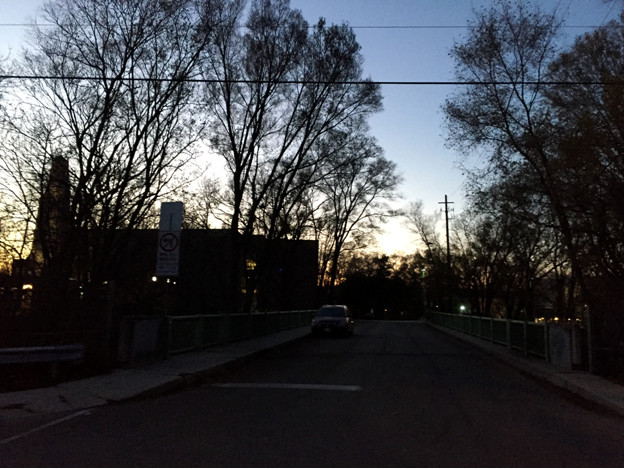
Myself turning right and proceeding through the Cathedral parking lot (7:34).
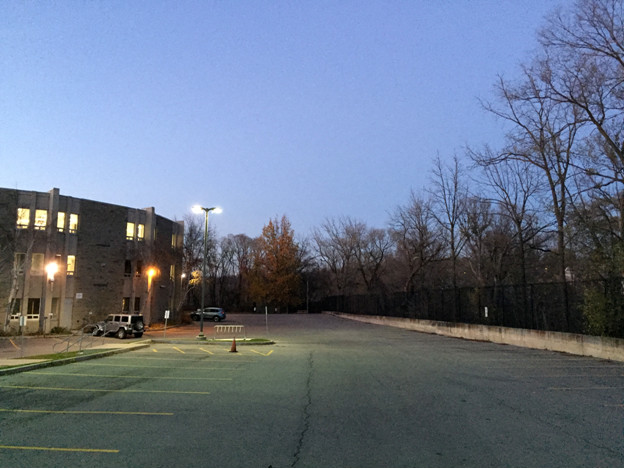
Myself passing through the gateway into Kay Drage (7:36).
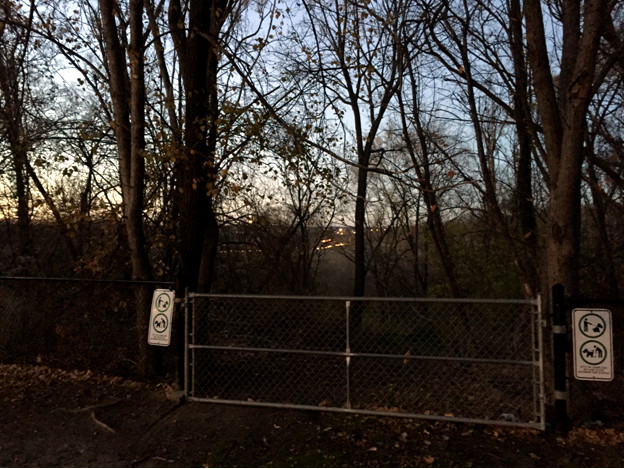
Myself entering the woods (7:37),
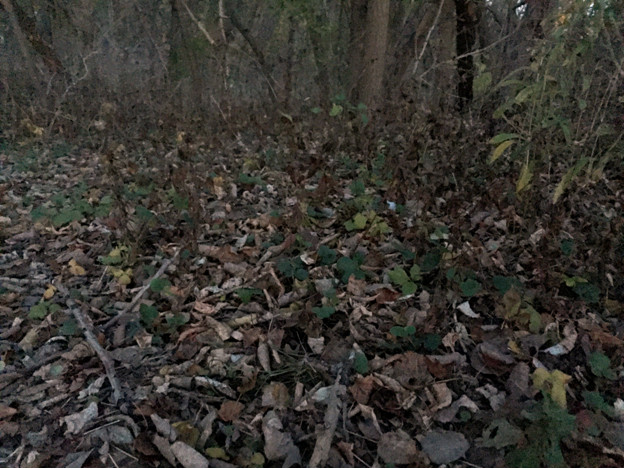
woods which, indeed, match the woods I'd always pictured when reading the opening lines of Dante's Inferno.
In those dark woods I would lurk. Passers-by would know that whatever my lone figure was up to could only be no good. So I would be as still as the stones and pray a walker's dog didn't catch my scent.
I looked at my watch. 7:29. The sequence you've just read I now did. It went according to script. There I stood, still as the stones, for what seemed an eternity. No one passed me, dogged or dogless or in any other mode. The train was late enough for dusk to become dark.
Then finally. The roar and the lights.
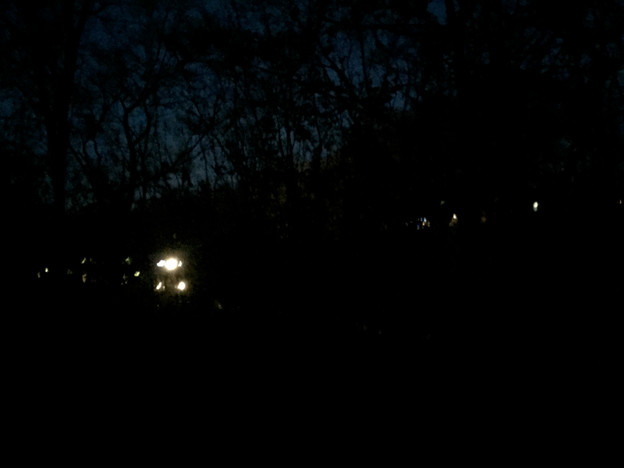
The commuters.
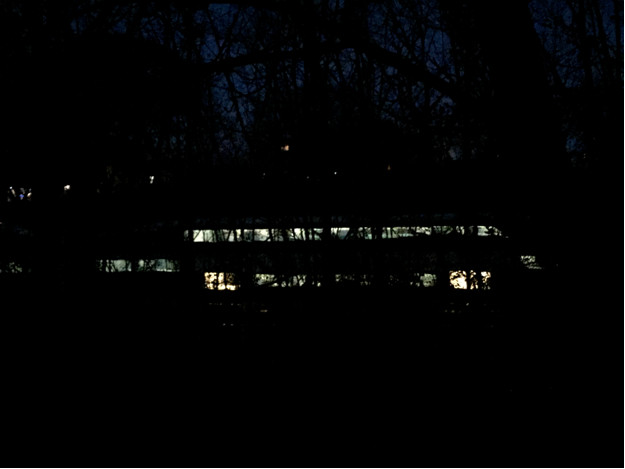
I was near enough that for a fraction of a second I glimpsed individual passengers, who vanished instantly to numberless dramas. I thought of Ezra Pound's electrifying verbal snapshot of the Paris Metro:
>The apparition of these faces in a crowd;
>Petals on a wet black bough.
I thought: This exact collection of strangers has never gathered together before and will never gather together again-a chance assembly so fleeting as to be barely real, and yet so overwhelmingly real. I thought-
But I shook useless reveries away. I had work to do. I approached the track carefully. I looked both ways. I placed my coins. One... Two...Three...
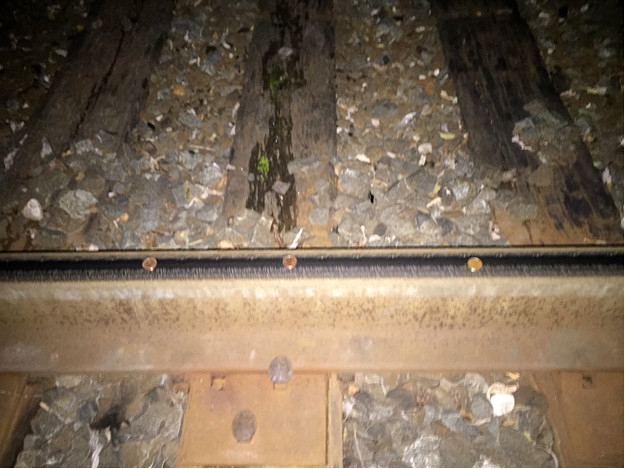
I put down 45. For from childhood practice I knew at least 20 would be lost.
I returned to the house, exhausted yet exhilarated. I showered. I slept the dreamless sleep of the fugitive in a safe house after days on the lam.
The sun rose. I awoke. I dressed. I walked casually to a scene that was as innocuous by day as it had been sinister at night. And there they were.
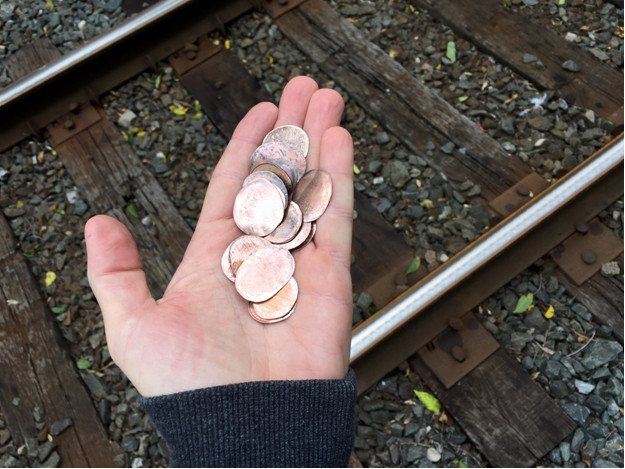
Marveling at their newfangled uniqueness, I rushed home. Tossing them onto my unmade bed, I photographed the sheet they spangled.
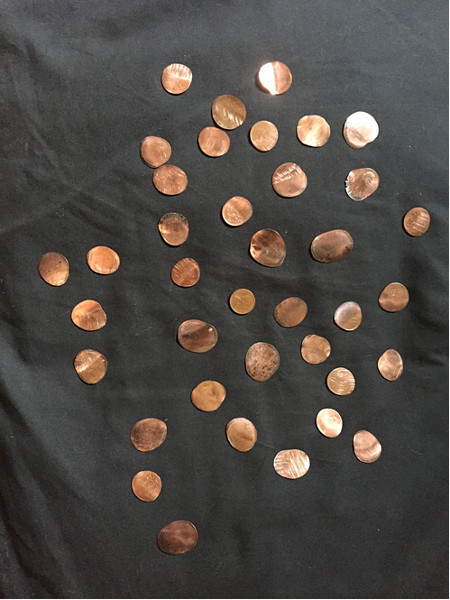
Not forty. But enough. Enough to set up a game of Nim. Which I hadn't played in years. And what 21st Century Canadian wouldn't want to play a game that involved reusing and recycling a redundant currency?
I've gotten ahead of myself. I need to provide a full disclosure of how my ways with currency were once more destructive to Canada's fiscal equilibrium than merely destroying a coin that was trivial when I was a child, and irrelevant now that the coin is redundant.
My assault on the monetary supply was considerably more disturbing during my high-school years.
For the conventional wisdom is correct. Destruction of coins leads to the destruction of folding money. Just as-to employ a 'truth' imparted by our teachers in the 70s-marijuana leads to heroin.
Once the needle goes in it never comes out.
—Larry Clark
It is 1980. My family has moved from Regina to Edmonton and I am in high school.

I've never gone back to look at the place. Once again I use Google for a viewing and am strangely relieved to find that the school's iconic totem pole has endured into the 21st century. Back then I never gave it much attention. Despite the fact that during assemblies our Principal described it as "a lightning-rod for school pride."
There was a persistent autumn ritual of students from a, let's say 'less-affluent,' high-school who attempted to chop down the totem-pole of our alma mater with an axe. The assault damaged the artwork, yet inevitably failed to bring the thing down. Had students compared notes with alumni of previous years, this failure could have been foreseen.
The centre of the totem was a steel pole rooted deep in earth and sunk into concrete. This perennial revelation lead me to suggest to my social studies teacher that the artwork's aboriginal authenticity was doubtful, a proposition which gained me only a look of scorn and - I believe but can't prove - a poorer grade.
It also led me to suggest to the woman who sat at the administration desk over lunch hour that future vandalism might be prevented by a sign explaining that the toppling of this noble symbol of our distinguished school - this school whose student body comprises Canada's future - requires nothing less than an orbital pipe saw and 10 km of extension chords plugged into the perpetrators' dismal subsidized housing, in the dismal slum for which their dismal school is the epicentre.
This got my name written down in a book, which I suspect is still filed somewhere in Edmonton Public School Board records. I lacked the self-awareness to see that my ostensible sallies at civic improvement were nothing more than misdirected Juvenalian satire.
Yes, I regarded the totem pole with scorn. In a city whose aboriginal population is considerable I don't recall, during my three-year tour, meeting a single aboriginal student. So it became my unarticulated metaphor for the disconnection of high school from any reality whatsoever. At the end of my first semester at the school I put the totem on a list of things I didn't have to deal with, and willfully averted my eyes when I passed it.
If I'm over-regarding it now, it's because I under-regarded it then. With the benefit of three decades distance I now look so closely at the area, that I see something that definitely wasn't there in 1980. In the bottom right of the frame at the vertical edge of the stone is a surveillance camera

angled at the pole.
In 1980, digital industries were just starting to be promoted by my physics teacher as promising career options that ambitious students should take seriously, despite the fact few of us had ever seen a computer. In 2015, digital systems are so quotidian that cheap surveillance cameras blossom even in stone. An easy way to protect a valued object 24/7/365. No more assaults upon it. Or if there are assaults, they are recorded and the perpetrators can be immediately brought to justice.
And again, to anyone who reads this and has pull with the EPSB: a "THIS OBJECT UNDER VIDEO SURVEILLANCE" sign could go a long way to avoid paperwork and rate increases with insurers.
So. Here I sit at my desk in Hamilton, hijacking a Google camera from my laptop, in order to observe a second camera. And both cameras are focused on the same object, an object as inert as they are. While I, the sole sentient entity in this triangle of voyeurs, am not witnessing the thing itself, but an observation loop of the thing. A loop that makes me feel as isolated as I felt in high school.
As suggested above, I went to the affluent school, but I sense you need particulars. I was one of the few students past the age of 16 who didn't drive to school. If I had driven in my parent's Impala, the car would have been assessed as the vehicle of a non-student parking illegally, and tagged and towed. Students drove shiny new cars, gifted the moment the student turned 16. And good ones: BMW, Mercedes, Porsche were standard.
The scale moved downward, of course. There were a few Volvos and Citroens driven by the children of recent immigrants. And once, by a circumstance no one could explain and which was the subject of endless cafeteria speculation, a Lada appeared, driven by an eastern European student in the early stages of learning English, hence unable either to defend the vehicle's functionality or to explain its provenance.
In fairness to our student body, the car and its owner were welcomed as refugees from an oppressive regime, and the vehicle regarded more with bafflement than with hostility. Rather as though an Amish student had mysteriously enrolled, and was parking his horse and buggy in the lot.
I was not like any of these students. I was from a bland residential neighbourhood 10 kilometres distant, a neighbourhood neither affluent nor impoverished, a neighbourhood most students couldn't have found on a map of Edmonton, a neighbourhood an easy walking distance from the school whose students laboured to destroy our totem-pole.
As a demonstration against the conspicuous consumption of the student population I'd frequently walk the full 10 kilometres home, a gesture that impressed no one, since few students knew where I lived, and I was out of sight within seconds, on a route they didn't pass in their vehicles.
I mention this only as another example of political gestures that completely missed the point. For this was also when I resumed my Quixotic assault on Canadian currency. And took it to the next level.
Minnesota Fats: I quit, Eddie. I can't beat you. Willie, give him the stakes.
—The Hustler
By High school I had graduated from Penny Squasher to Nim Hustler.
There wasn't much in the way of esoteric TV programming in Edmonton in 1980. The best chance at seeing anything more remarkable than Diff'rent Strokes was a late night slot that showed foreign movies, though they were preëmpted more times than not when an Oilers game went longer than scheduled.
However, on the night in question the game ended on time, and the movie I saw was Alain Resnais's L'Année Dernière à Marienbad. This was a world away from scorn at Soviet automobile production, and destruction of totem poles in the name of school spirit. LADàM is a movie in which nothing happens but anything is possible and all of it exquisite European formalwear.
Here's what 'happens' [LOL]. A romantic liaison, from the previous year (hence the title) is suggested, but only as a possibility, and one whose truth value not only doesn't get verified for the viewer, it doesn't even get verified for the man and woman in the alleged relationship (which I consider a depressing comment on the part that relationships play in shaping our future identities, but that's just me.)
The look of the film emulates Rebecca-period Alfred Hitchcock, and in case the audience doesn't notice, Resnais forces AH into a bizarre cameo appearance so easy to miss that it requires not only film geeks but probably whispers from the director to film geeks and some photo-shopping to point out that the master of suspense is present in the world's least suspenseful movie.
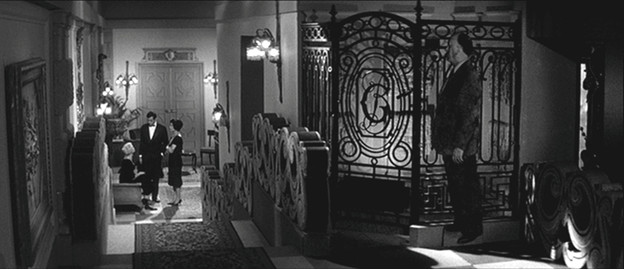
On my screen I had to crop and lighten the shot to confirm it was indeed AH levitating - his signature pose, stylized and expressionless as a figure on a totem pole - in the centre-right of the rectangle.
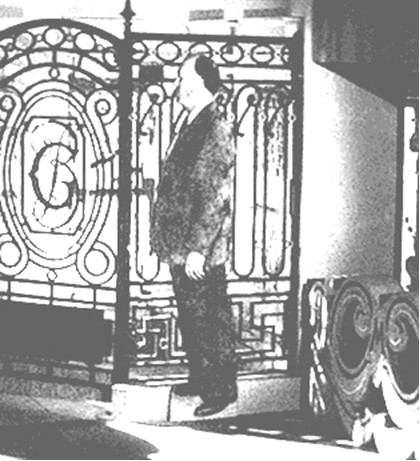
It was no more practical to fly AH into Marienbad (or thereabouts, since in fact none of the shooting was done in Marienbad, providing another of a thousand irrelevancies) for the shoot than it is to fly me out to the prairies for this essay. So they used a cardboard cutout. If you lamented that the master's practice of passing through his own films wasn't sufficiently contrived, now he hovers in someone else's.
What interested me wasn't hipster references (and there were many beyond the AH profile, all of which I missed) but the obsessive playing of Nim. The Marienbad resort is, among other things, a casino, and Nim grows steadily into an offside gambling event, one which no doubt infuriated the house, who get no piece of this action.
Surely in the dusty bookstacks of a film library there's a doctoral thesis exporing LADàM's upside-down Marxism, where the overprivileged seize the means of production and draw gamblers and observers away from the roulette tables.
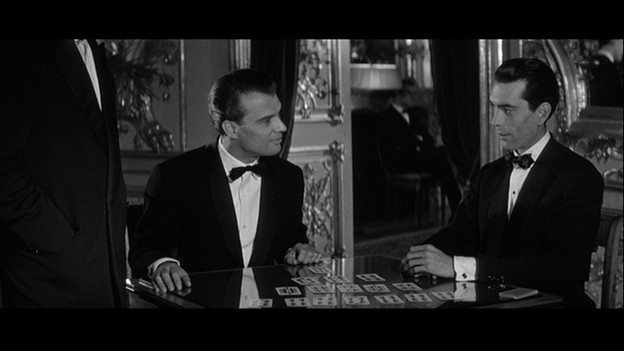
Nim is a game for two players and can be played with any collection of small objects that can be easily snatched away. In LADàM we see it played with matchsticks, dominos and playing cards, providing a texturally diverse yet geometrically monomaniacal motif to the mise-en-scène.
Here's what you do.
Line up four rows consisting of 1, 3, 5, and 7 objects. You can see what I've chosen.
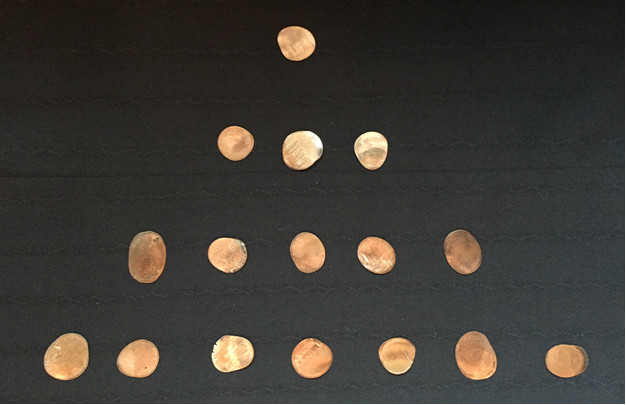
Players can flip a coin for who goes first. Though it's probably best if you don't use coins like the ones depicted above.
Each player has to take objects from a row. All or any number, but from one row only per turn. How you win is don't get stuck taking the last object.
What struck me about LADàM is that the character who persistently initiates the game (on the right in the still above and no, none of the characters in this film has a name-it's that kind of a French film) never loses. A fact that's remarked upon in the sparse and gnomic dialogue.
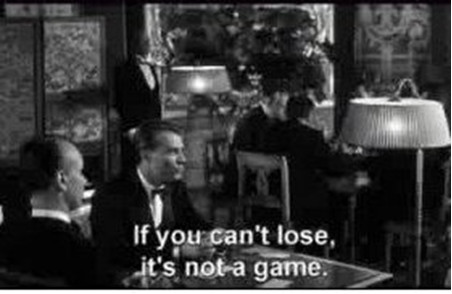
After seeing the movie I practiced this game with close friends, not winning necessarily, but figuring out a basic strategy: if at all possible, get the numbers down to two rows that leave the opponent with the same number in each. E.g. 5 and 5,

4 and 4, etc. Thenceforth, whatever your opponent takes, adjust the rows to keep them even. Down to 2 and 2, where the outcome is obvious.
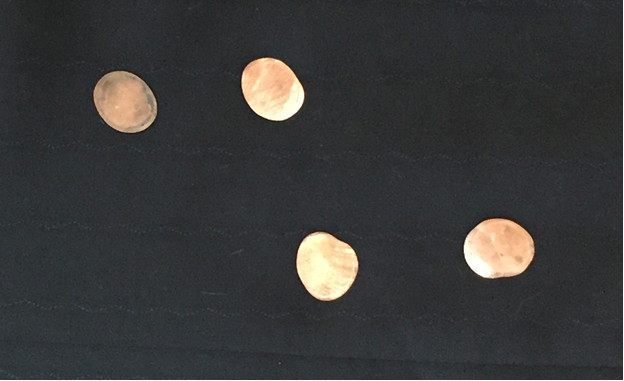
She takes one from a row, you wipe out the entire other row leaving her with the last object. She takes out an entire row you take one from the remaining row, leaving her with the last object.
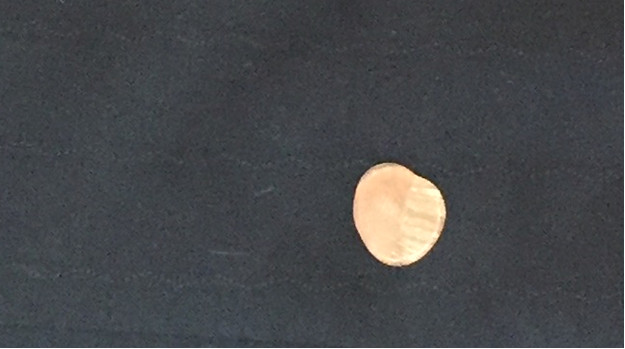
It's not complicated. I conceived a scheme.
I'd never been able to beat anyone at chess or checkers. And even with the chance element I seldom won at backgammon. My only advantage with Nim was that probably no one at my school had heard of it. Anyone with even a trace of a math brain would beat me by the third game. But what if I played one game only with each opponent?
The next week I tried my plan out during lunch hour. As I suspected, no one else had watched LADàM that night. I played for a dollar and won the dollar.
I played in the cafeteria, by the vending machines. Next to the vending machines was a monolithic metal machine that you could put a dollar in (dollars were paper then, don't forget) and it would break the dollar into quarters you could then use in the machine.
This is where my recidivist behavior with currency comes in. I discovered that a dollar could be torn into many pieces and then taped back together with cellophane tape and the machine would still recognize it. To invoke the Criminal Code, I'd moved beyond simply defacing currency. I was now uttering currency that has been defaced.
I would win a dollar and then tear it to pieces. More pieces each time.
Everyone loves patterns and routine, and my prestidigitation with folding money was something of a lunchtime diversion. That the students gathered to watch the game and its aftermath had mullets, and T-shirts promoting Led Zeppelin and KISS was a delightful parallel to the tuxedoed guests at Marienbad. An audience so different sartorially; yet so similar in stance and attentiveness. The parallel nourished my desire to meld connections with disconnections. These were rare moments of high school bliss.
Once I even bet a newcomer a dollar that I could get the machine to recognize the reassembled dollar and I did and won his dollar and felt compelled to tear that dollar into still more pieces than the one before. (If you're interested, twenty was the maximum number if pieces I could re-tape and fool the machine into accepting.) But no one took the bet against that one working, which was good, at least as far as my diet went.
You see, while I'd like to say that my protest against materialism was socialist in nature, and that I shared the bags of chips I bought with my winnings, I did no such thing. I wasn't even an anarchist properly speaking. I was simply that most predictable of 17-year-old misfits: a narcissist outraged at inequity, but with neither the ability to articulate it, nor the ambition to reform it. I consumed my winnings privately.
With loves, and hates, and passions just like mine,
They were born and then they lived and then they died.—Morrissey
The final Canadian penny was minted at the RCM's Winnipeg plant

on the morning of May 4, 2012.
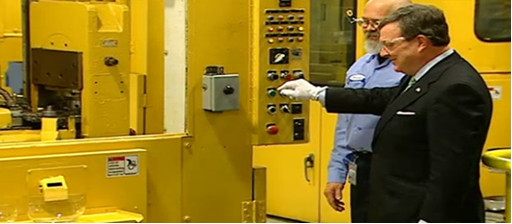
I easily found an image of Finance Minister Jim Flaherty, in AH cameo pose, at the Winnipeg plant, pressing the button that minted the last coin. But I couldn't find anything on the fate of the coin itself.
Where did it go? Did someone at the mint say "Oh, go on, Jim. It's the last penny. You came all the way out here. It's yours." And did he wisely refuse, foreseeing a scandal that named everything from "conflict of interest" to "missappropriation of funds" in his political downfall?
Staring into the middle distance I dream of Penny having a cozy but somehow lonesome childhood. In a family of countless older siblings and schoolmates, but no younger ones.
Penny ages, but is never as aged as her peers. Add to that that for longer than any of the others she witnesses the redundancy of her race. Brothers and sisters and friends disappear one by one. Contrary to the fate of valid currency, decrease in supply does not increase her value. She's lonelier and less valued everyday. Parents in the form of nickels abandon her. Aunts and Uncles in the form of dimes and quarters, Grandparents in the form of loonies, Great Grandparents in the form of toonies, all of them ignore her. To all of them she's the contemptible end of a generation that can't get jobs.
In my dream Penny seeks out coin collections, and even there discovers fewer and fewer of her family. And those she meets are inert as lepidoptera on pins.
Finally there's no one at all. From Victoria to St. John's. No one. She feels like someone long retired, attending her high school reunion at the age of 110 and discovering she's alone. Everyone else is annihilated or recycled. The totem pole has turned from mascot to memorial.
In my dream, time moves rapidly forward. It is decades in the future when I learn that in light of her historic importance Penny was implanted with a micro-transponder at birth. She's been located and placed in a display at the Canadian Mint.
I think of the Struldbrugs of Gulliver's Travels, who at a certain advanced age are pronounced legally dead despite being physically immortal. Like the Struldbrugs, Penny is declared valueless despite her undying penniness. The thought of this is more than I can bear.
Like a sequence in an Alfred Hitchcock movie, I see myself breaking into the Mint and rescuing Penny. Mounted Police are in pursuit as we make our escape through the streets of Winnipeg.
In my dream I too have advanced to an age beyond anything I could have imagined. I understand her loneliness. But unlike Penny, my death is as inevitable as it is imminent. While she needs her form to be actively extinguished, in order that her soul may find deliverance. Otherwise she faces eternity as an exhibit.
I reach the railroad track (a moving train is the one thing you can always find in Winnipeg) and place her carefully on the middle of the rail just as I feel the rumble of the approaching engine. The Mounties and their horses are closer, but the train is faster.
In seconds Penny's capture or Penny's release will be determined. It's up to relationships of motion and distance now, ones that I should have paid more attention to in grade 10 physics, in order to estimate velocities and distances and calculate times.
My dream ends. You decide the outcome.
As I'm writing these final lines it's gorgeous outside. The last warm day we're likely to get this year. I'm heading down to the tracks. Meet me there if you're up for a game.
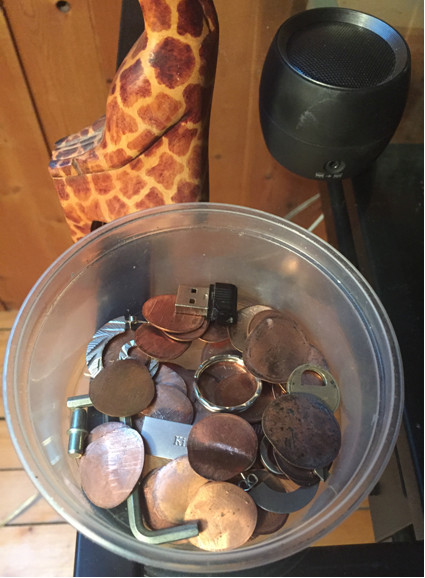
By Comment from Elisaday (anonymous) | Posted December 05, 2015 at 23:32:26
For a while now, I have been reading these essays. I find them like strange gems among so much disillusion, sadness and grievances.
Why is it that when material things with no heart, no feelings reach their end, make us feel melancholic?
I wonder why our neighbors in the south do not want to get rid of their pennies. Mark, when they do, will you write for us another essay like this one?
One day I will move to Hamilton. I am grateful for living in Canada!
Keep telling us stories Mark…. Thoughtful, playful….. Optimistic….
You must be logged in to comment.
There are no upcoming events right now.
Why not post one?